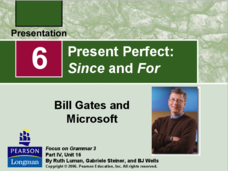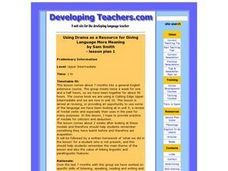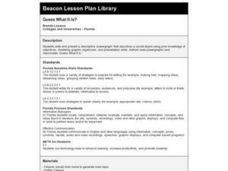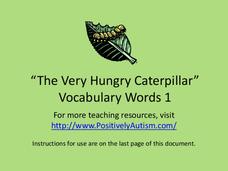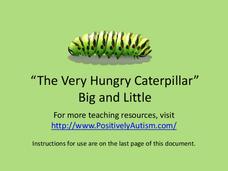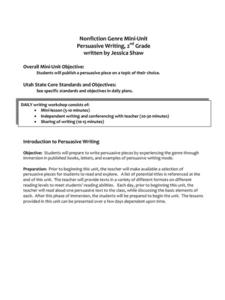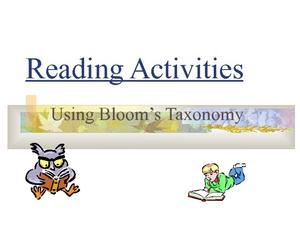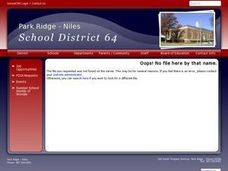Houghton Mifflin Harcourt
Core Analysis Frame: Fiction
Dig into any piece of fiction with a series of analysis questions. There are two levels of questions provided: basic and in-depth. The basic questions can be copied double-sided onto a single piece of paper, while the in-depth questions...
Nancy Fetzer's Literacy Connections
Expository Paragraph
Upper elementary and middle school writers learn how to craft an expository paragraph by following the six steps detailed in a 48-page instructional guide. Learners learn how to write six different types of informational paragraphs:...
Pearson
Present Perfect: Since and For
Present perfect tense doesn't mean that something is perfect, just that it's continuing from the past into the present. Demonstrate proper usage of present perfect verb tense with a slideshow presentation, which features a passage...
Curated OER
My Insect Report
Is your class writing a report on insects? If they are, you have to check out this great set of worksheets. It provides a well-scaffolded system they can use to organize their research findings in order to compose a well-structured...
Curated OER
Infinitives and Beyond
For this infinitives worksheet, students read a one page information text about infinitives. Students then answer 10 fill in the blank questions about infinitives.
Curated OER
The Important Things About Nouns
Pupils create pages to be published into a eBook. Students read a story and identify nouns and attributes that describe the noun. Using a creative writing process, pupils write paragraphs and combine them for their eBook. Students read...
Curated OER
Using Drama as a Resource for Giving Language More Meaning
Students revise and provide spoken and written practice of modal verbs in the past for criticism.
Curated OER
Guess What It Is?
Third graders write and present a descriptive 'powergraph' that describes a secret object using prior knowledge of adjectives, clustering graphic organizers, and presentation skills. Authors read powergraphs and classmates 'Guess What It...
Curated OER
Pluperfect
In this pluperfect worksheet, students review and discuss how pluperfect verbs are formed and fill in the gaps with the correct verb in five sentences or phrases.
Education Outside
Creature Jeopardy!
After conducting research on a given scientific animal name, group members take a walk around their school and look for the specified animals in that classification. Then, they come back to their worksheets and create five creative clues...
Curated OER
What Is Haiku
Middle schoolers engage in a instructional activity that is concerned with the study of poetry while focusing on Haiku as a format. They practice reading a variety of different pieces of literature in order to increase exposure. Students...
Curated OER
Science Lesson for Grade 12
Twelfth graders perform dihybrid crosses and calculate phenotype and genotype ratios. In this series of science lessons, 12th graders explain the process of anodizing aluminum. They research on the benefits and harm caused by resonance...
Curated OER
Explore Brothers and Sisters throughout Literature
Celebrate Brothers and Sisters Day on May 2, 2013 by studying sibling pairs in literature.
Positively Autism
The Very Hungry Caterpillar Vocabulary
Moon, eggs, leaf, sun, caterpillar. Prior to reading Eric Carle's classic tale, introduce vocabulary for The Very Hungry Caterpillar with these picture cards that also include the vocabulary word printed in large type.
C.S. Lewis Foundation
Study Guide to The Four Loves
This well-designed, and easy-to-understand study guide is a goldmine in understanding the ideas and philosophies of C.S. Lewis’s The Four Loves. The resource easily breaks down the four loves (affectionate, friendship, romantic, and...
Positively Autism
The Very Hungry Caterpillar Big and Little Activity
A big caterpillar, a little caterpillar. A big butterfly, a little butterfly. Images from Eric Carle's The Very Hungry Caterpillar model for learners with autism the difference between big and little.
Curated OER
Nonfiction Genre Mini-Unit: Persuasive Writing
Should primary graders have their own computers? Should animals be kept in captivity? Young writers learn how to develop and support a claim in this short unit on persuasive writing.
Curated OER
Reading Activities Using Bloom's Taxonomy
This short, yet effective, presentation gives pupils many great tips on increasing their enjoyment of what they read and improving their comprehension. The categories of tips include analyzing, remembering, understanding, applying,...
Curated OER
An Author Report on Beverly Cleary
Students examine Beverly Cleary as a reader and an author. They write a letter to Beverly Cleary that details their personal journey as readers and writers after reading her work and keeping a reading journal.
Curated OER
The Outsiders
Are you working on an Outsiders unit? Use this list of activities to deepen your middle schoolers' understanding of the novel. After reading S.E. Hinton's novel, young readers work on three required activities, including participating in...
Curated OER
Left-to-Right Reading
Left-to-right, left-to-right, that's the way we read and write! Watch this short video clip and teach your young learners this chant before they start writing!
GCSE Modern World History
Mao's China
Here is a great textbook chapter on China's establishment as a communist state in 1949 and the effects of World War II on the nation. The first page prompts learners to complete a timeline activity as they read the material,...
Curated OER
So Much Depends Upon...Sixteen-Word Imagery Poems Inspired by Love that Dog by Sharon Creech
After reading Love That Dog by Sharon Creech (and possibly shedding a few tears), middle schoolers work on their own sixteen-word poems with a Six Trait writing activity. They focus on word choice in this activity to capture an...


